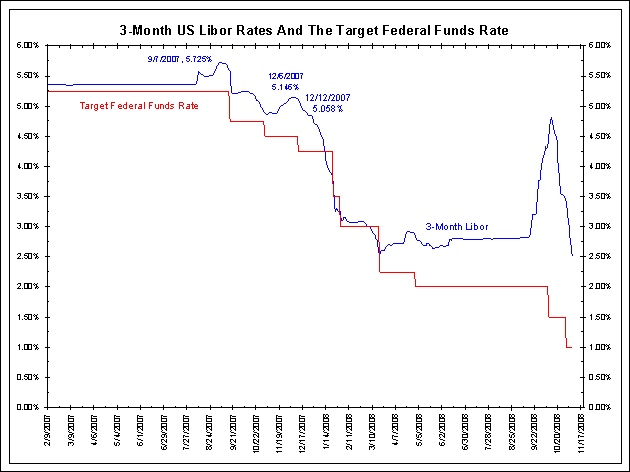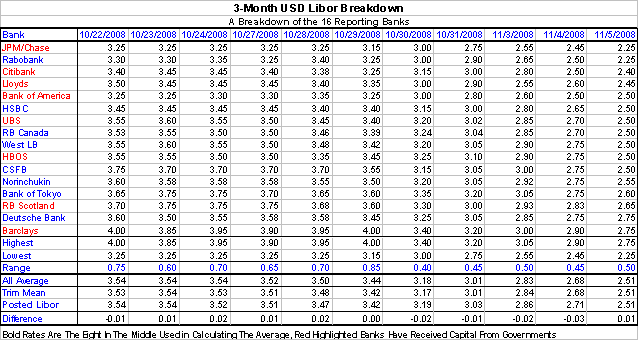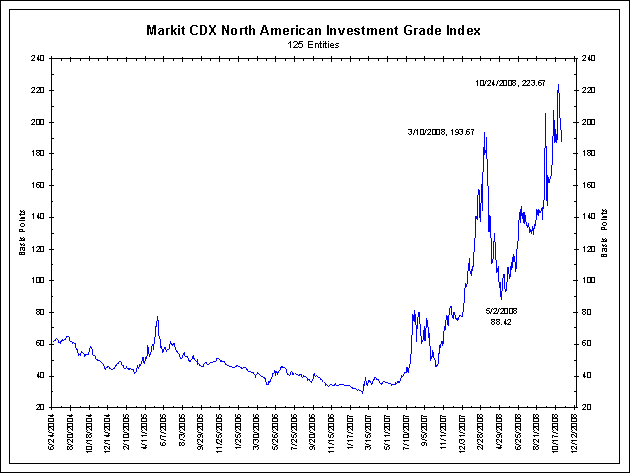- The Financial Times – Dollar lending rate reflects crunch easing
The benchmark floating rate for dollar lending on Tuesday fell below the level that prior to the bankruptcy of Lehman Brothers in mid-September, providing a further sign that the credit crunch is slowly easing. The decline in the three-month dollar London Interbank Offered Rate, however lags behind the Federal Reserve’s action in cutting its overnight rate in half to 1 per cent last month. Interest rate futures price in a further cut for the Fed’s rate to at least 0.75 per cent by the end of the year…While rates are coming down, traders say money market funds are still not willing to lend to banks at this juncture. The bulk of activity is being done through money market and commercial paper programmes instituted by the Fed, reinforcing the central bank’s role as lender of sole resort. With the Fed and US Treasury fully supporting short-term lending and banks, the stress in the system has been medicated, but it remains to be seen when the market can resume working without external support, say traders. - Bloomberg.com – Libor’s Biggest Drop Fails to Match Fed, Spur Loans
Credit markets are still creaking even after the biggest decline on record in the rate banks say they charge each other to borrow dollars. The London interbank offered rate, or Libor, for three- month loans fell to 2.51 percent today, from 4.82 percent on Oct. 10. The rate is still 151 basis points more than the Federal Reserve’s target interest rate for overnight bank loans, compared with an average of 22 basis points in the five years before the global credit crisis began in August 2007. “Banks are cutting back, the economy is in a deepening recession and in that environment, I don’t think banks are going to become a lot more willing to extend credit soon,” said Jan Hatzius, chief U.S. economist in New York at Goldman Sachs Group Inc., the world’s biggest securities firm. - The Associated Press – Treasurys edge up after manufacturing contraction
An another positive sign, the cost of insuring against investment-grade corporate bond defaults, as measured by the Markit CDX North America Investment Grade Index, slipped Tuesday, according to Phoenix Partners Group. This suggests that people were generally less worried about bond defaults. These improvements are not enough, however, to ease credit worries for the numerous troubled companies out there in need of loans to tide them over during this year’s tough economy. “Let’s not equate the lowering of the crisis temperature with saying that our problems are behind us,” said Howard Simons, strategist with Bianco Research in Chicago.

<Click on chart for larger image>

Comment The story above hits the nail on the head, and is something we addressed last week. That is, both LIBOR and commercial paper are “heavily medicated” (to use the phrase above) through massive government intervention. We cannot use these measures or derivatives of these measures (such as the Ted Spread or the OIS/LIBOR spread) as indications that credit is getting better. Only when governments pull back from these markets and they show they can stand on their own can we hail their “improvement” as a sign that the credit crisis is easing. Since governments are not about to pull back, we are still left to wonder if credit is improving.
Comment Above we said commercial paper and LIBOR are “too medicated” to be used as indications of credit improvement. So, what can be used? Markets that (for now?) do not have heavy government involvement. One such market is the CDX North American Investment Grade Index. We will leave it to the reader to decide if this measure is signaling the credit crisis is passing. We think it is too early to tell, as we say above.
